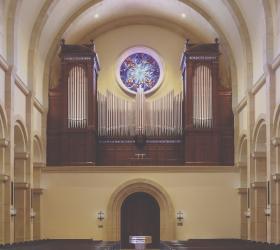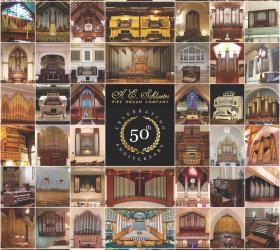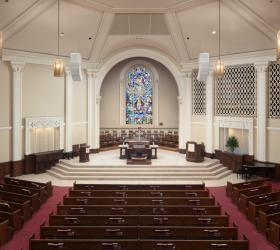
Randall Dyer & Associates,
Jefferson City, Tennessee
Trinity Evangelical Lutheran Church, Sanford, North Carolina
“Multum in parvo” seems, once again, to be the catchphrase in design of small organs. The instrument at Trinity Evangelical Lutheran Church in Sanford, North Carolina, probably fits the category, since it has only eight carefully chosen ranks of pipes, half of which are at 8′ pitch. While we have always considered a solid ensemble the most important part of any organ, this instrument does not weave flutes, gemshorns, and mutations in and out at different pitches on different manuals for “added flexibility” as we might have done in unit organs of the past; it simply does not need it.
After seeing an instrument we had built for a sister congregation, John Southern, chairman of the organ committee at Trinity, approached us for ideas about replacing their small one-manual tracker organ, which, though it had served well for many years, was extremely limited.
As we contemplated their situation and budget over a period of months, we were made aware of a mechanically complete, but “pipeless” 1986 Schlicker organ in Pittsburgh. It was in excellent condition, and was attractive to us as organbuilders, because we could select, scale, and voice the pipes we wanted, to create the sound we wanted in the room.
We used all the available notes on the existing chest and added more chest space. Case skirting, which already matched the woodwork in the church, was extended to enclose the additions, and a swell box was constructed. The wood pipes of the new 16′ Bourdon were stained to match. New pipes were provided by Stinkens, Matters, Oyster, and Mcusick, and the electro-mechanical switchgear of the console was gutted and replaced with a modern solid-state system.
Though actually on “unit” chests, the stoplist is conceived as that of a straight organ and is provided with regular couplers. With only minor alteration, it could have been built as a new slider-chest organ. The fact that no rank plays at multiple pitches on the manuals allows the organ to develop a clean, full ensemble sound, providing excellent registrations for congregational and choral accompaniment, and for playing the literature, the latter amply demonstrated during the inaugural concert by Dr. Florence Jowers of Lenoir-Rhyne University.
The congregation was open to our idea of moving the altar and communion rail forward to place the organ front and center, where it looks good and projects well into the room.
We regard this as a new organ, because the resulting instrument plays and sounds like one of our organs. The concept, whether using existing or all-new equipment, is viable for many small churches desiring a good service-playing instrument, capable of years of reliable service far exceeding that of non-pipe substitutes.
We cannot say enough about the pleasant dealings we had with this congregation, who allowed us the freedom to practice our craft. The result is an organ of which we are extremely proud, and we think it is important for churches and musicians everywhere to know that small, affordable organs are still being built.
Tamara Lewis is organist and director of music.




